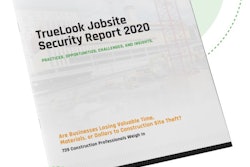When the economy took a dive in 2008, many equipment owners worried they would see an increase in theft as it became more difficult for many to acquire equipment through honest means. It turned out, however, that theft did not increase with the down economy. Instead, it grew as economic recovery gained momentum. Today, the National Insurance Crime Bureau (NICB) estimates almost $1 billion worth of construction equipment is stolen each year, and much of it is rented. What can you do to protect your investment?
According to Courtney DeMilio, associate vice president with LoJack Corp., there's been an enormous spike in theft of rented equipment over the past two years and the reason is simple: there's more equipment out on the jobsite and that equipment is vulnerable.
Traditional equipment theft, she explains, typically happens over weekends when equipment is called off rent but left to sit until it can be picked up the following week.
"Thieves make off with the equipment on Friday night, and the equipment isn't missed until Monday morning," DeMilio says. During that time, a machine can be moved great distances, making it more difficult for law enforcement to find and retrieve it.
"The number one thing rental companies can do to minimize their theft risk is to pick up their equipment as soon as possible after it's called off rent," DeMilio says. "Leaving it on the jobsite over the weekend is an invitation to thieves."
Equipment is vulnerable
Ryan Shepherd, general manager of the National Equipment Register (NER), said one of the reasons why construction equipment is easily stolen is because there's no title or registration associated with it, and as a result, no paper trail to follow ownership.
Various manufacturers have their own unique identification or product identification number but, overall, there's no conformity within the industry.
In addition, unlike automobiles, which have their own unique key for starting, construction equipment is typically one key fits all. While this makes theft easier on thieves, it isn't likely to change since having an individual key for each machine on a jobsite isn't practical when various operators are hopping on and off equipment all day long.
Protect your investment
If your budget allows, consider installing equipment tracking systems (telematics) on high-value equipment. In addition to monitoring its location, many telematics systems allow you to establish authorized hours of operation and/or an operating perimeter (geofence) for the machine. If the equipment is started up during non-authorized hours or leaves the geofence area, an alert is issued, warning you of the event. Some applications will automatically immobilize the equipment to prevent its use.
A simpler, less expensive approach is to install simple tracking devices on each piece of equipment. Discretely located on the machine, these devices are virtually invisible and "wake up" only if/when the unit is stolen. Once a piece of equipment is reported missing, law enforcement sends out a signal to the device, which then automatically returns information about its location.
Another way to mitigate your risk of equipment theft is by registering your equipment. With no other national equipment registration program in place, NER views itself as the DOT/DMV of equipment, Shepherd says. "We've become the main source for law enforcement when trying to identify construction and agriculture equipment," he says. "Registering equipment helps law enforcement identify equipment after a theft, significantly increasing the odds and speed of recovery significantly."
Prevention is key
In addition to tracking devices and registration, DeMilio at LoJack says there are several simple and proactive things you can do to minimize your risk:
- Pick up equipment as soon as possible after it's called off rent. Don't let it sit on a jobsite for the weekend, especially if it's a three-day holiday.
- Know your customers. Take your time and examine the accounts you're opening.
- Ensure your customer's credit card goes through. If it doesn't, consider this a red flag.
- Don't accept cash.
- Know your competitors and share information about suspicious customers and bad accounts.
- Press charges when there are internal issues. Theft is sometimes an inside job. If you know the culprit, don't let him or her off the hook.
Even the best prevention measures don’t always work, so take steps to make it as easy to recover equipment and materials as possible. Where feasible, stamp an ID number in both an obvious and a hidden area. Consider painting equipment in unique or easily identifiable colors with the corporate logo clearly visible.
Develop a list of equipment serial/product identification numbers. If possible, maintain a file of color photos and notes with other identifying information.


















